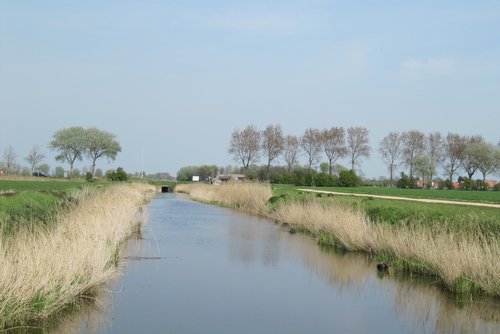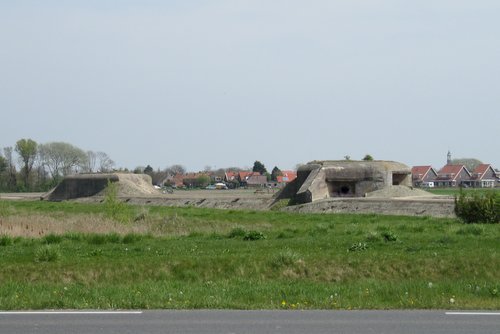Landfront Vlissingen - Stützpunkt Kolberg - Bunker 2 type 631 & Tank Barrier
The following text can be read on the information board of the Bunker Preservation Foundation:
First of all, general information about the Landfront Vlissingen.
Landfront Vlissingen
Vlissingen was an important position during World War II and was strongly fortified as part of the German defense line "Atlantikwall". To protect the fortress against attacks from the rear, a defensive belt was constructed on the landward side of the city. This so-called Landfront consisted of a kilometer-long anti-tank ditch with dozens of casemates for machine gun and anti-tank gun behind it. The line started in the west in the dunes of Groot-Valkenisse and ran across Koudekerke to the Canal through Walcheren. On the eastern side of the canal, the Landfront continued its way towards Ritthem, where the line in the Schorerpolder ended at Fort Rammekens. Most of the Landfront has been preserved.
After the general information above, Koudekerke's defense itself can be read further on the information board.
The text:
The defense of Koudekerke, Stp. Kolberg
The Landfront was set up as a linear defense, that is to say a zigzag-running anti-tank ditch with casemates behind it that could cover the front field of the line. The defense was primarily conducted by machine gun casemates. The machine gun entered the First World War and turned out to be a formidable weapon. This was reason for the Germans to make frequent use of this weapon in the Atlantic Wall and to build heavy concrete combat positions (bunkers) for it. For example, no less than 600m3 of concrete was used to set up one machine gun, with the weapon positioned behind an enormously heavy and expensive armor shield. The relationship between the cost price of the machine gun and the construction costs for the bunker setup seems to be rather out of balance. At places where the anti-tank ditch crossed existing roads, it was decided to demolish most of the bridges over the canal. Only the most important roads remained accessible. Because these offered an attacker with tanks and armored vehicles quick access to the fortress, the bridges were equipped with explosive charges and covered with anti-tank guns.
Koudekerke, referred to by the Germans as Stützpunkt Kolberg, was defended by five machine-gun casemates (type 623 and 630) and three artillery bunkers (type 631 and 625) with anti-tank guns. The gun casemates had a firing field over the Middelburgsestraat and the old Provinciale weg.
The bunker you are now in front of is a gun bunker of type 631, Schartenstand für 4,7cm Festungpak (t), specifically designed for a Czech-made cannon. This concerned a fast-firing anti-tank gun with a caliber of 4.7 cm, which had been captured en masse by the Germans. The effectiveness of the weapon was rather limited, as it was actually only usable against lightly armored vehicles.
Here too the urgent question from the Bunker Preservation Foundation and TracesOfWar:
Please:
Many bunkers on Walcheren and the Bevelanden are on private land. The dunes are off limits, please ask for permission before viewing a bunker. Also keep in mind that for many owners Sunday is a day of rest. Do not cause any inconvenience
Do you have more information about this location? Inform us!
Source
- Text: Mia van den Berg / Stichting Bunkerbehoud
- Photos: Jeroen Koppes (1, 2, 3), Mia van den Berg (4, 5)
Nearby
Museum
- Stützpunkt Lohengrin - Bunkermuseum Zoutelande bunkertype 143 - Zoutelande
- Stützpunkt Lohengrin - Bunkermuseum Zoutelande bunkertype 502 - Zoutelande
- Keizersbolwerk Vlissingen - Vlissingen
Point of interest
- ‘Der Boede’ Estate - Koudekerke
- Information Sign The Battle of Dishoek - Dishoek
- Castle Ter Hooge - Middelburg
Monument
- War Memorial Koudekerke - Koudekerke
- Memorial 47th Royal Marines Commando Dishoek - Dishoek
- Memorial 47 Royal Marine Commando - Dishoek
Cemetery
- Bombardment 17 May 1940 Memorial - Middelburg
- Commonwealth War Graves Flushing (Vlissingen) - Vlissingen
- Dutch War Graves (Noorderbegraafplaats) - Vlissingen
Remembrance Stone
- Stumbling Stones Park de Griffioen 22 - Middelburg
- Stumbling Stones Park de Griffioen 10 - Middelburg
- Stumbling Stones Park de Griffioen 2 - Middelburg
Fortification
- Landfront Vlissingen - Stützpunkt Kolberg - Bunker 1 type 631 - Koudekerke
- Landfront Koudekerke - Bunkertype 623 - Koudekerke
- Landfront Vlissingen - Stützpunkt Kolberg - Bunker 3 type 623 - Koudekerke






